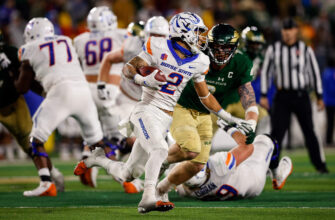At its heart, football is gloriously simple: two teams, a field, and a round ball. Yet, as the world gears up for the unprecedented 48-team FIFA World Cup across the vast landscapes of the U.S., Canada, and Mexico in 2026, that “round ball” is anything but simple. Enter Trionda, Adidas’ latest official match ball, a silent marvel of engineering meticulously crafted to perform flawlessly, almost invisibly, on the grandest stage.
More Than a Name: Decoding Trionda`s Identity
The name Trionda itself is a thoughtful nod to its monumental setting. `Tri` proudly represents the three host nations – the United States, Canada, and Mexico – each signified by a distinct color woven into its design: blue, red, and green. The graceful, curved patterns across its surface are a visual homage to `onda,` the Spanish word for wave or vibe. It’s a design that speaks volumes about unity and regional spirit, yet its true ingenuity lies far beneath the surface, in the years of meticulous research and development that have culminated in its striking form.
Conquering Climates: The Adaptive Design Challenge
The 2026 World Cup will span 16 host cities, from the coastal cool of Vancouver to the high-altitude warmth of Mexico City. This presents an unprecedented challenge: how does one ball perform consistently across such wildly diverse climatic conditions? Adidas` answer lies in Trionda`s innovative texture. Engineers meticulously designed the ball with an extra grip, ensuring that whether a player is kicking it in humid Miami or dry Denver, the tactile sensation and control remain precisely the same. This wasn`t guesswork; it involved rigorous testing, initially in controlled humidity chambers, followed by real-world trials across seven host cities with professional players from MLS and Liga MX, gathering feedback vital for perfection.
The Brain Inside: AI and the Future of Football
Building on the foundations laid by its predecessor, Al Rihla from the 2022 Qatar World Cup, Trionda incorporates an even more refined AI-powered chip. This tiny marvel, strategically repositioned to the side of the ball for enhanced performance, is not merely a gimmick. It’s a sophisticated data-gathering tool designed to provide real-time insights during matches. Imagine referees making faster, more accurate decisions, powered by immediate data on touches, trajectory, and impacts. This technological leap promises to revolutionize game officiating and, crucially, to inform Adidas` next generation of innovations. As the game’s tactical evolution demands ever more precise analytics, the Trionda’s chip unlocks unprecedented depth of understanding, tracking metrics previously impossible to quantify.
Aerodynamics: The Art of Effortless Flight
The ghost of past World Cup balls, like the much-maligned Jabulani (2010) and Telstar 18 (2018) – balls criticized for their unpredictable flight paths – looms large in the memory of players and fans. Adidas has taken these lessons to heart. Trionda`s construction features just four fluid panels, a significant departure from Al Rihla`s twenty geometric ones. This seemingly aesthetic change is purely functional. The specific panel shapes, combined with precisely engineered groove lines and seam lengths, are critical to its aerodynamic stability. Extensive wind-tunnel testing at institutions like Loughborough University meticulously evaluates factors such as in-flight stability, launch speed, swerve, and precision. The goal? A ball that behaves exactly as a player intends, minimizing variables and maximizing skill.
The Ultimate Test: Player Validation
Scientific rigor is paramount, but the ultimate validation for any football is on the pitch. Adidas` development process ensures that Trionda isn`t just a lab success; it’s a player’s ball. From amateur enthusiasts to elite professionals, countless individuals have provided invaluable feedback, influencing its final design and feel. This human element ensures that the cutting-edge technology never detracts from the pure joy and control players expect. National teams will have the opportunity to train with Trionda months before the tournament kicks off, ensuring they are perfectly attuned to its nuances.
A Silent Participant, A Profound Impact
When the first whistle blows on June 11, 2026, in Mexico City`s Estadio Azteca, the Trionda will likely go unnoticed by most. And that, paradoxically, is its greatest triumph. Its years of meticulous design, climate adaptation, embedded AI, and aerodynamic perfection are all engineered to make it a seamless, intuitive extension of the players` will. It represents the pinnacle of sports engineering, a testament to how deep science can dive into the simplest elements of the beautiful game, ensuring that the focus remains, as it should, on the drama and skill unfolding between the two posts. The Trionda is not just a ball; it`s a silent partner in history in the making.








